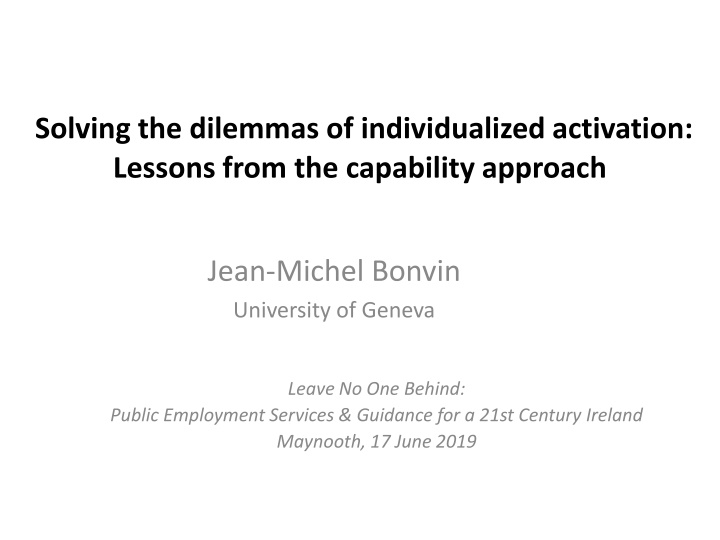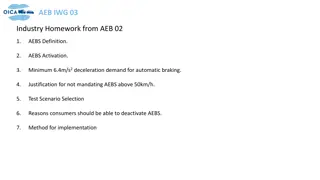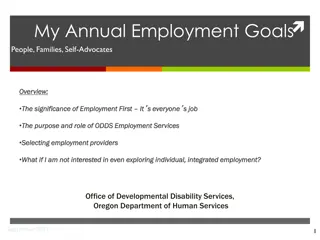Lessons on Individualized Activation and Public Employment Services
Insights on implementing individualized activation strategies using the capability approach, focusing on real freedom, valuable job opportunities, and avoiding paradoxes in public policies. The lessons emphasize the importance of considering individual and contextual factors, adjusting program content, creating links with the labor market, and addressing accountability issues.
Download Presentation

Please find below an Image/Link to download the presentation.
The content on the website is provided AS IS for your information and personal use only. It may not be sold, licensed, or shared on other websites without obtaining consent from the author.If you encounter any issues during the download, it is possible that the publisher has removed the file from their server.
You are allowed to download the files provided on this website for personal or commercial use, subject to the condition that they are used lawfully. All files are the property of their respective owners.
The content on the website is provided AS IS for your information and personal use only. It may not be sold, licensed, or shared on other websites without obtaining consent from the author.
E N D
Presentation Transcript
Solving the dilemmas of individualized activation: Lessons from the capability approach Jean-Michel Bonvin University of Geneva Leave No One Behind: Public Employment Services & Guidance for a 21st Century Ireland Maynooth, 17 June 2019
The capability approach in a nutshell Capabilities as: a) Real freedom Individual factors matter, but not only (e.g. supply and demand) Need for resources and guidance: take people as they are in terms of - Abilities and competencies - Motivation - Availability b) To lead a life one has reason to value Not any job, but a valuable job Vs. paternalistic and libertarian approaches 2
Lessons for individualized activation (1) 1. - Do not use ability, motivation and availability as selection criteria but as targets to be reached they are a matter of individual and contextual factors (vs. blaming the victims) Otherwise, paradoxes of public policies (they are aimed to help and support, but reinforce vulnerability) a) Paradox 1: public policies as factors of vulnerability due to their level and duration b) Paradox 2: due to restrictive conditions that result in selecting beneficiaries c) Paradox 3: due to restrictive conditions that result in self- excluding mechanisms Take people as they are
Lessons for individualized activation (2) 2. Adjust the content of programs - Follow-up and guidance - Progressive and individualized approach - Accountability mechanisms - This has a cost, but it is worth! Otherwise, paradoxes of public policies: a) Paradox 4: insufficient means to reach targets b) Paradox 5: due to conditions that result in creaming beneficiaries c) Paradox 6: due to conditions that create self-exclusion mechanisms (reducing sense of entitlement)
Lessons for individualized activation (3) 3. Create a link with the labour market - Guidance programs as a reliable signal to potential employers (cf. validation of prior experience) - Develop partnerships with employers Otherwise paradoxes: - Paradox 7: Valuable social policies are not valued by outside actors - Paradox 8: Valuable social policies create islands rather than act as bridges
Conclusion Public policies in the field of unemployment may act as factors reinforcing vulnerability due to: a) Their inadequation in financial and quality terms b) Their submission to conditionalities that result in selective and self-excluding practices c) Their acting as islets instead of bridges. Saving in the short term is not the adequate solution in the long-term. Over-protecting or over-responsibilizing beneficiaries may be counterproductive (issue of respect)























